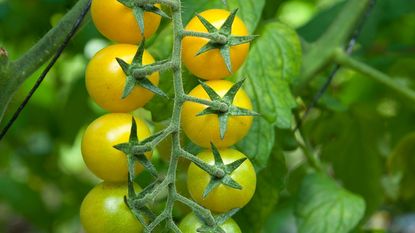Growing Lemon Drop Tomato Plants


One of the most prolific plants in my garden is the Lemon Drop tomato (Solanum lycopersicum). This beauty is a sport from Snow White cherry plants, a happy accident, of which most gardeners like myself love. It produces sweet large cherry tomatoes with a golden color and lovely scent. Heirloom cherry tomato plants are open pollinated, organic and just the right size for eating out of hand.
Background Info on Lemon Drop Tomato Plants
The genesis of this popular cherry tomato is not unique. Many of our best loved plants have arisen from a cross or natural hybridization of a planted species. In this case, Lemon Drop cherry tomatoes were found by an elderly tomato breeder who was a member of the Seed Savers Exchange. J.T. Sessions recognized a winner when he saw it and saved the seeds of the plant, offering them for trade on the SSE. And I am glad he did. The incidental plants became a hit and are now available at many nurseries and in most organic seed catalogs.
Growing Lemon Drop Cherry Tomatoes
If you are like me, you can't wait to start your seeds and have indoor flats growing by the end of February. This is a great idea for the long season veggies and fruits since I have a relatively short season in which to produce. Tomatoes are one of the items that do great started indoors. By the time the soil has warmed up and all danger of frost is past, you can have some really big plants, ready to start blooming and producing. Sow the seeds 6 weeks before the last frost in flats ¼ inch deep. Keep them moderately moist and in bright indirect light. Harden off the plants before transplanting them outside. Choose a sunny location with organically amended soil. At planting time, bury the stem up to the first set of true leaves. The stem will produce new roots soon, which leads to healthier producers. Avoid planting Lemon Drop cherry tomatoes where you have had tomatoes before. Crop rotation is important to reduce overwintered pests and disease that target specific plant groups - and this is one plant you want to keep growing again and again. This type of tomato is indeterminate. That means it will require staking and you will have fruit ripening throughout the summer. Water plants deeply once per week to really soak the roots. Pinch off suckers to force the energy into producing shoots. Harvest heirloom cherry tomatoes when they are firm but fully colored, as over ripe fruits can be mealy. Enjoy these golden delights fresh, in sauce or as part of a unique bruschetta.
Gardening tips, videos, info and more delivered right to your inbox!
Sign up for the Gardening Know How newsletter today and receive a free download of our most popular eBook "How to Grow Delicious Tomatoes."
-
 10 Best Apartment Plants To Turn Your Small Space Into An Oasis
10 Best Apartment Plants To Turn Your Small Space Into An OasisThe best apartment plants can lend an ambience of the tropics, brighten up a space, or add a touch of drama, and turn an apartment into a relaxing oasis.
By Amy Grant
-
 Grow a Bathroom Oasis: 8 Best Bathroom Plants With No Light or Low Light
Grow a Bathroom Oasis: 8 Best Bathroom Plants With No Light or Low LightSome apartment dwellers grow the best bathroom plants with no light or low light. Read how one of our favorite plant lovers does it in the big city.
By Teo Spengler